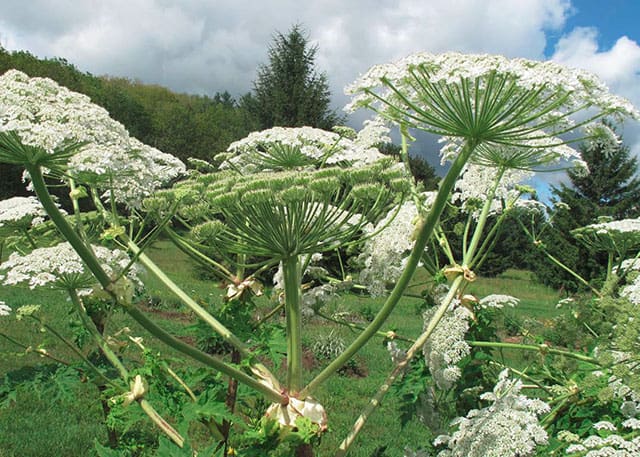This toxic plant can be found in Hamilton. Here’s how to spot it and deal with it
Published July 20, 2020 at 4:33 pm

Giant Hogweed, a toxic invasive plant, has been found in parts of Hamilton, but do you know what it looks like and how to deal with it when you spot it?
Giant Hogweed, a toxic invasive plant, has been found in parts of Hamilton, but do you know what it looks like and how to deal with it when you spot it?
The City of Hamilton has provided some guidance to help residents in dealing with the plant, that to the untrained eye looks like your average everyday weed.
“We have found this plant along Spencer Creek and roadways in Dundas,” the city says on their website. “Some plants have been found on private property in Dundas and Flamborough.”
The clear watery sap of Giant hogweed contains toxins that can cause severe dermatitis (inflammation of the skin), according to the government of Ontario website.
People who come into contact with the plant can get severe burns if the sap comes into contact with skin and the skin is then exposed to sunlight.
Symptoms occur within 48 hours and consist of painful blisters. Purplish scars may form that last for many years.
The City of Hamilton’s website notes that the healing process can be slow, and your skin may remain sensitive to sunlight for the rest of your life.
There have been media reports that blindness may occur if the sap gets into your eye.
There are a number of plants that look very similar to Giant hogweed such as Cow parsnip, Purplestem angelica, Woodland angelica, Valerian, Lovage, and Queen Anne’s-Lace.
The white flower clusters resemble those of Queen Anne’s-Lace, but tend to be more widely spaced and can form a flower-head almost one metre wide, according to the province’s website.
So how do you know if you’re looking at Giant Hogweed?
Here are some of the plant’s typical traits:
- 1 to 5.5 metres in height (3 – 15 feet)
- Large, deeply cut leaves with sharp coarse teeth, reaching widths in excess of 1 m (3 feet)
- Stems are covered in coarse whisker-like hairs, with red-purple spots
- White, umbrella-shaped flowers up to 1.2 m (4 feet) across
- Giant hogweed grows along roadsides, ditches and streams
- It invades old fields and native habitats such as open woodlands

The stem of a Giant Hogweed plant is covered in coarse whiskers and feature purple-brown spots. Photo courtesy Scottish Invasive Species Initiative

The Giant Hogweed’s leaves are deeply cut and have spiky edges. Photo courtesy the Scottish Invasive Species Initiative
So what should you do if you come into contact with Giant Hogweed?
The City of Hamilton says that if it’s on your property, you should contact a licensed weed exterminator to remove it.
Residents are asked not to compost Giant Hogweed and to not put Giant Hogweed out as leaf and yard waste, green cart or waste material.
If any sap touches your skin:
- wash the affected area immediately with soap and water
- keep the affected area out of the sun
- see your doctor if you have a reaction
If sap gets in your eye:
- Immediately rinse it out with water and contact your doctor
For more information on removal and safety concerns around hogweed, visit the province’s website.
According to the City of Hamilton, if you find hogweed on your property or on city-owned property it should be reported. To do that, call 905-546-2489. Visit the City of Hamilton’s website for more localized information on this invasive plant.
Main photo courtesy Credit Valley Conservation
insauga's Editorial Standards and Policies advertising





